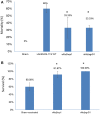Comparative Genomics of Aeromonas hydrophila Secretion Systems and Mutational Analysis of hcp1 and vgrG1 Genes From T6SS
- PMID: 30687246
- PMCID: PMC6333679
- DOI: 10.3389/fmicb.2018.03216
Comparative Genomics of Aeromonas hydrophila Secretion Systems and Mutational Analysis of hcp1 and vgrG1 Genes From T6SS
Abstract
Virulent Aeromonas hydrophila causes severe motile Aeromonas septicemia in warmwater fishes. In recent years, channel catfish farming in the U.S.A. and carp farming in China have been affected by virulent A. hydrophila, and genome comparisons revealed that these virulent A. hydrophila strains belong to the same clonal group. Bacterial secretion systems are often important virulence factors; in the current study, we investigated whether secretion systems contribute to the virulent phenotype of these strains. Thus, we conducted comparative secretion system analysis using 55 A. hydrophila genomes, including virulent A. hydrophila strains from U.S.A. and China. Interestingly, tight adherence (TaD) system is consistently encoded in all the vAh strains. The majority of U.S.A. isolates do not possess a complete type VI secretion system, but three core elements [tssD (hcp), tssH, and tssI (vgrG)] are encoded. On the other hand, Chinese isolates have a complete type VI secretion system operon. None of the virulent A. hydrophila isolates have a type III secretion system. Deletion of two genes encoding type VI secretion system proteins (hcp1 and vgrG1) from virulent A. hydrophila isolate ML09-119 reduced virulence 2.24-fold in catfish fingerlings compared to the parent strain ML09-119. By determining the distribution of genes encoding secretion systems in A. hydrophila strains, our study clarifies which systems may contribute to core A. hydrophila functions and which may contribute to more specialized adaptations such as virulence. Our study also clarifies the role of type VI secretion system in A. hydrophila virulence.
Keywords: Aeromonas hydrophila; Hcp; T6SS; VgrG; comparative genomics; secretion systems.
Figures



Similar articles
-
Classification of a Hypervirulent Aeromonas hydrophila Pathotype Responsible for Epidemic Outbreaks in Warm-Water Fishes.Front Microbiol. 2016 Oct 18;7:1615. doi: 10.3389/fmicb.2016.01615. eCollection 2016. Front Microbiol. 2016. PMID: 27803692 Free PMC article.
-
Tad pili contribute to the virulence and biofilm formation of virulent Aeromonas hydrophila.Front Cell Infect Microbiol. 2024 Jul 31;14:1425624. doi: 10.3389/fcimb.2024.1425624. eCollection 2024. Front Cell Infect Microbiol. 2024. PMID: 39145307 Free PMC article.
-
Type II Secretion Is Essential for Virulence of the Emerging Fish Pathogen, Hypervirulent Aeromonas hydrophila.Front Vet Sci. 2020 Sep 25;7:574113. doi: 10.3389/fvets.2020.574113. eCollection 2020. Front Vet Sci. 2020. PMID: 33088835 Free PMC article.
-
An Asian origin of virulent Aeromonas hydrophila responsible for disease epidemics in United States-farmed catfish.mBio. 2014 Jun 3;5(3):e00848-14. doi: 10.1128/mBio.00848-14. mBio. 2014. PMID: 24895303 Free PMC article.
-
Virulence Factors of Aeromonas hydrophila: In the Wake of Reclassification.Front Microbiol. 2016 Aug 25;7:1337. doi: 10.3389/fmicb.2016.01337. eCollection 2016. Front Microbiol. 2016. PMID: 27610107 Free PMC article. Review.
Cited by
-
Prediction and Analysis in silico of Genomic Islands in Aeromonas hydrophila.Front Microbiol. 2021 Nov 29;12:769380. doi: 10.3389/fmicb.2021.769380. eCollection 2021. Front Microbiol. 2021. PMID: 34912316 Free PMC article.
-
Development of Bioluminescent Virulent Aeromonas hydrophila for Understanding Pathogenicity.Pathogens. 2023 May 2;12(5):670. doi: 10.3390/pathogens12050670. Pathogens. 2023. PMID: 37242340 Free PMC article.
-
Polyinfection in Fish Aeromoniasis: A Study of Co-Isolated Aeromonas Species in Aeromonas veronii Outbreaks.Pathogens. 2023 Nov 10;12(11):1337. doi: 10.3390/pathogens12111337. Pathogens. 2023. PMID: 38003801 Free PMC article.
-
A Global Survey of Hypervirulent Aeromonas hydrophila (vAh) Identified vAh Strains in the Lower Mekong River Basin and Diverse Opportunistic Pathogens from Farmed Fish and Other Environmental Sources.Microbiol Spectr. 2023 Feb 23;11(2):e0370522. doi: 10.1128/spectrum.03705-22. Online ahead of print. Microbiol Spectr. 2023. PMID: 36815836 Free PMC article.
-
Secretion Systems in Gram-Negative Bacterial Fish Pathogens.Front Microbiol. 2021 Dec 15;12:782673. doi: 10.3389/fmicb.2021.782673. eCollection 2021. Front Microbiol. 2021. PMID: 34975803 Free PMC article. Review.
References
LinkOut - more resources
Full Text Sources
Molecular Biology Databases
Research Materials
Miscellaneous

